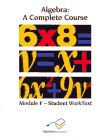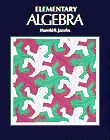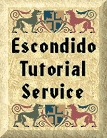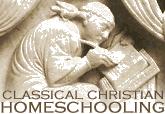Text Only
(Printer-Friendly)
coming soon
Contents
Introduction
Trivium
Grammar
Dialectic
Rhetoric
Homeschool
Curriculum
CCH FAQ
CE Links
Favorite
Reciprocal
What’s New
About CCH
Search CCH
Art History

Classical Christian
Homeschooling:
Classical Education
at Home
WebMaster:
Christine
Miller
CCH’s Online Catalog: Dialectic Stage Math: Grades 7-9
This page last revised:
June 2001
Copyright © 1997-2001
|
Option 1: VideoText Algebra
For 7th-9th grades and up, or
after completion of a complete course in Arithmetic as described in Grammar Stage Math. Algebra is the next step after
Arithmetic, and is the language in which all higher math study occurs, and is therefore
the foundation for all higher math study, including Geometry. VideoText Algebra combines
the material learned in Algebra I and II into one 1-year course. This is CCH’s top
choice for Algebra instruction in the dialectic stage.
Option 2: Harold Jacobs Mathematics
For 7th-9th grades and up, or
after completion of a complete course in Arithmetic as described in Grammar Stage Math. Harold Jacobs texts presents the subjects
of Algebra and Geometry in a dialectic way, allowing children to think through and analyze
the concepts presented. Algebra and Geometry are one-year courses; CCH recommends taking
Algebra in 7th grade, then a Logic course in 8th grade, then
Geometry in 9th grade.
Option 3: Euclid’s Elements
For 7th-9th grades and up, or
after completion of an Algebra course, either VideoText, Harold Jacobs, or something else.
For 2000 years Euclid’s Elements have been used to teach logical thinking through the
study of geometry.
Option 4: Online Mathematics Tutorials
For 7th-9th grades and up, or
after completion of a complete course in Arithmetic as described in Grammar Stage Math. Online Mathematics Tutorials provide an
excellent education in Algebra and Geometry.
 VideoText Algebra VideoText Algebra
Thomas E. Clark
CCH’s top choice for Algebra instruction, for 7th-9th grades and
up, or after completion of a complete course in Arithmetic as described in Grammar Stage Math. VideoText Algebra is a unique approach to
algebra among courses available. First, it contains all the material covered in both
Algebra I and Algebra II in one course. Years ago, there were only two mathematics courses
required for high school graduation--one year of Algebra, and one year of Geometry. When
it was decided to increase mathematics instruction, a second year of Algebra was tacked on
after the traditional Algebra - Geometry progression, called Algebra II. But since it had
been over a year since the student had taken an Algebra class, the majority of the Algebra
II textbook was a repeat of Algebra I. In only the final few chapters of the text was
there any new material, and that is the way it has continued from that day to this. But it
is craziness to take Algebra II after Geometry--a complete understanding of Algebra is the
foundation of all higher mathematics, including Geometry! Mr. Clark, mathematics teacher,
math textbook author for traditional text publishing companies, and former superintendent
of mathematics instruction for the state of Indiana, has therefore combined the complete
subject matter of algebra, Algebra I and II, in one course. When the student has completed
VideoText Algebra, he should receive credit for a one-year course in Algebra I and a
one-year course in Algebra II.
Second, VideoText Algebra instructs the student first in the language of
mathematics, its grammar and syntax, if you will, and therefore gives the student vital
tools to truly understand algebra, the language in which all higher mathematics is done.
This approach makes algebra simple to understand for even the most math-phobic. I know,
because my oldest daughter, who has since graduated from homeschool high school, was math
phobic. (Not any longer, thanks to VideoText Algebra.) We tried Saxon Algebra I, which did
nothing but cause her hours of tears and frustration daily, and added to her
I-knew-I-couldn’t-do-math mentality. She then studied Harold Jacobs Elementary
Algebra, which she did complete with a B average, with much labor and determination, over
the course of two years. But when we chose VideoText Algebra for her Algebra II course,
she cried tears of joy when she first began working in it. “I finally understand
math! I am not dumb in math after all!” were her exact words. It broke my heart, but
made me extremely grateful to Mr. Clark for his unique approach.
Third, VideoText Algebra tells the truth about mathematics, something that
even Jacobs’ Algebra sometimes avoids. For example in the first chapter of
Jacobs’ Algebra, he states that no number can be divided by zero, for the answer is
meaningless. Period. The student takes that on faith, and remembers it with no further
explanation. In VideoText Algebra however, students divide numbers by zero, to find out
what happens. (Yes, it CAN be done.) They learn why division by zero is meaningless, and
that learning why really satisfies their natural questions and solidifies the basic
principles in their memory, with understanding.
The lessons in VideoText Algebra are taught on video, and include 5-7
minutes of instruction. The exercises are contained in the Student Workbook, and include
20 problems per lesson. That’s it. When the student learns why, and understands the
principle, he does not have to do 50-100 problems per lesson to get formulas drilled into
his head by rote. Complete solutions to every problem, including every step worked, come
in the Solutions Manual for the teacher or parent. This lets the parent go over problems
missed with the student, who can then see exactly where he went wrong, and why. VideoText
Algebra is expensive, because of the videos. This is the only expensive program I
recommend in my whole catalog, for any subject. But the 6 modules can be purchased
separately, as the student needs them over the course of the year, so the parent in effect
can make payments on the program. The organization and presentation of the material to be
learned is so simple, elegant, well-done, and unique among algebra courses, that it
justifies the expense in my mind.
The following Harold Jacobs student texts can be ordered from Amazon.com.
While some teacher’s helps can be ordered from Amazon, some can not. However, all the
teacher’s helps are in fact in print as of July 1, 2001. Contact the publisher, W. H. Freeman and Company,
to obtain teacher’s helps not available through Amazon.com. Be sure to have the ISBN
numbers of the materials you would like to order in front of you when contacting the
publisher.
 Elementary
Algebra Elementary
Algebra
Harold R. Jacobs
For 7th-9th grades and up, or after completion of a complete
course in Arithmetic as described in Grammar Stage Math.
The Jacobs texts are self-instructing with the material presented in a dialectic way of
encouraging children to think through the concepts presented. Harold Jacobs says of his
series, “What a wonderful thing it would be if we could make each and every one of
our lessons entertaining as well as informative! [I have] made this a major goal ... [as
well as] to help students learn how to teach themselves. ... I think that reading the
lesson should be an important part of every assignment and have tried to write each one in
such a way that it can be read with understanding.” He succeeds. Harold Jacobs Elementary
Algebra (ISBN 0716710471) covers all the material in Saxon’s Algebra I, and some
of the material in Saxon’s Algebra II. Seventeen chapters thoroughly cover
fundamental operations, functions and graphs, integers, rational numbers, equations in one
and two variables, simultaneous equations, exponents, polynomials, factoring, fractions,
square roots, quadratic equations, real numbers, fractional equations, inequalities, and
number sequences. Each chapter contains multiple lessons that introduce that
chapter’s concept line upon line and logically. Each lesson contains plenty of
practice exercises arranged in four sets. Set I reviews ideas from previous lessons, sets
II and III apply the concepts of the current lesson, and Set IV challenges advanced
students. In this way each lesson can be custom designed, if need be, for slower, average,
and advanced students. The answers to Set II problems are in the back of the student text;
the answers to Set I, III, and IV problems are in the Elementary
Algebra Teacher’s Guide (ISBN 0716710757). The texts also include mid-term and
final year reviews which help prepare the student for the semester exams (purchased
separately, ISBN 0716710773) or which can be used in place of semester exams.
 Geometry Geometry
Harold R. Jacobs
For 8th grade and up, or after completion of a course in Algebra
(Algebra I and II). Harold Jacobs Geometry (ISBN 071671745X) draws from Euclid, teaches
how to write proofs, and includes work in proofs in each of its chapters. A unique aspect
of this text is its Algebra review built into the end of each chapter. It is a traditional
geometry course, covering the topics of Introduction to Euclid, the Nature of Deductive
Reasoning, Points, Lines, and Planes, Rays and Angles, Congruent Triangles, Inequalities,
Parallel Lines, Quadrilaterals, Transformations, Area, Similarity, Right Triangles,
Circles, Concurrence Theorems, Regular Polygons and the Circle, Geometric Solids,
Non-Euclidean Geometries, and Coordinate Geometry. The Geometry text is laid out similarly
to Elementary Algebra, with exercises contained in three Sets per lesson. The answers to
the exercises as well as additional teacher helps are in the Geometry
Teacher’s Guide (ISBN 0716717484) The texts also include mid-term and final year
reviews which help prepare the student for the semester exams (purchased
separately, ISBN 0716717476) or which can be used in place of semester exams.
 Euclid’s
Elements Euclid’s
Elements
Sir Thomas Heath, translator and editor
For 8th grade and up, or after completion of a course in Algebra
(Algebra I and II). Euclid’s Elements is an alternative text to teach Geometry.
Actually, modern Geometry texts are the alternative, as Euclid has been the standard
Geometry text for millenia. Working Euclidean proofs provides an excellent education in
logical and precise thinking. Abraham Lincoln said that besides the Bible, Euclid was his
most treasured book, as its study enabled him to become the devastingingly logical and
articulate lawyer for which he was famous. This unabridged publication of the original
enlarged edition contains the complete English text of all 13 books of the Elements, plus
analyses of each definition, postulate, and proposition. Please note that this edition
actually comes in 3 volumes: Volume 1
includes Elements Books I-II, Volume 2
includes Elements Books III-IX, and Volume 3
includes Elements Books X-XIII.
 Escondido Tutorial Service Mathematics
Tutorials Escondido Tutorial Service Mathematics
Tutorials
Fritz Hinrichs, tutor
For 7th-9th grades and up, or after completion of a complete
course in Arithmetic as described in Grammar Stage Math.
Escondido Tutorial Service is the pioneer in internet tutorials for home and private
schooled students. Tutor Fritz Hinrichs, a graduate of St. John’s College, is also a
recognized expert in classical Christian education, being written about in numerous
publications (The New York Times and The Future of
Home Schooling by Michael Farris, for example) regarding distance learning and
classical education, as well as appearing as a frequent columnist and conference speaker.
He uses the Saxon texts for Algebra, and Euclid’s Elements for Geometry. The pitfalls
of Saxon’s teaching method are lessened in this case, as the tutor mediates the
lesson presentation and is able to present the material in a dialectic stage manner. Saxon Algebra 1/2, Saxon Algebra I, Saxon Algebra II, and Euclidean Geometry Online Tutorials are all
available.
This online catalog is made possible through an association with Amazon.com.
Clicking on the book cover will take you to Amazon’s information page about that
book. You can look at its price, availability, any discounts currently taken for that
title, reviews of the book, and other information, as well as order it if you decide to
purchase the book. You can even place books in your shopping cart and save them for
purchase at a later time. You can continue to add or delete books from your shopping cart
until you are satisfied with your order and ready to purchase. Clicking on your
browser’s “Back” button will bring you back to this catalog.
Sometimes books go out of print, or the publisher runs out of stock. Any
book not available from Amazon.com for any reason can be searched using AddAll.com, a book shopping site which will scan Amazon
as well as Barnes and Noble, Powell’s Books, Book Close Outs and many other new and
used book sites. Be sure to also check BookFinder.com
for out of print book searches.
Still have questions? Ask
me!
 
|


